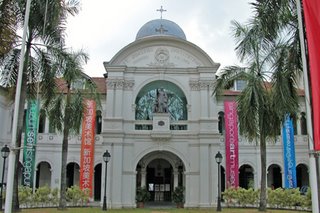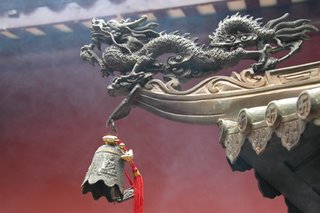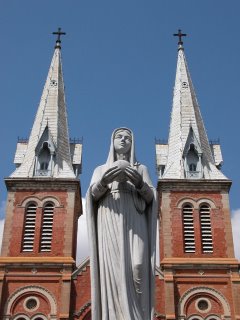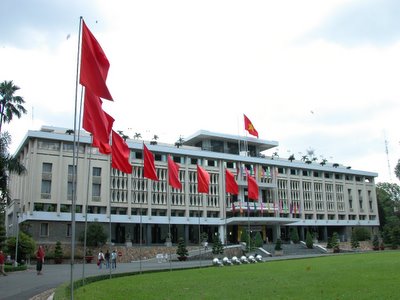
Do you see this picture? Cute how JAL (Japan Airlines) differentiates wheelchair users between those flying Economy and those flying First/Business Class.





Xin Tian Di (the New Heaven and Earth) is located at the periphery of the French Concession. In the olden days, Shanghai is divided into different districts as a result of the Westerners trying to carve out a part of the city for their own fellow compatriots. Thus, Shanghai has the British Concession, the American Concession (these two later became the International Settlement), and the French Concession.
When I arrived at Xin Tian Di, I saw immediately the restaurant that my friend had recommended, Xin Ji Shi. I thought of going in but decided to walk around and take pictures first. The area retained and renovated the beautiful old-brick shikumen-style buildings (stone gatehouses). The complex, opened in 2001, is buzzing at night with the young crowd converging for eats and drinks and a little shopping. Instead of neon-advertising lights, the area employs small flags to announce the names of the businesses.
It was fortunate that I decided to walk around first, because then I bumped into T8, a restaurant that had been widely praised by critics and included in the Conde Nast top 50 restaurants in the world. My friend had also mentioned this restaurant to me, although he himself had never been. I will write a review of this restaurant in my yet-to-be created site, but for now, let it be known that this restaurant with a cuisine of Mediterranean and Asian fusion is worth going. The "M on the Bund" may have a balcony with a nice view of the Huang Pu River, but the food pales in comparison to T8. Stephen Wright, the executive chef here, is very friendly and approachable. The open kitchen -a square area where he and his staff performed their daily and nightly culinary tasks, protrudes into the dining room. From here he can survey the entire ground floor.
After this very satisfying lunch, I went to take a very long stroll into the French Concession, a walk that lasted for about 4 hours. I just followed the recommended stroll by the guidebook but occasionally strayed and went into the alleys and back ways, which always provided great opportunities for viewing the old "shikumen" style architecture. Of the 111 pictures shot today, some were of adults sitting, reading, working, socializing, and children playing. Yes, 111 pictures today and about 147 yesterday: ah, the joy of digital camera. You can just take as many with no worries about the developing cost. Even if you make a mistake, you can just take another one and delete the undesired ones later.
There was not much of a landmark in today's walk, except for the former house of Sun Yat Sen and Zhou En Lai on Sinan Lu; but the neighborhood alone was remarkable. I was surprised to find how clean Shanghai was: no trash lying around. (It was etched rather deep in my mind that most, if not all, Chinatowns in the western world and in Indonesia were always messy and littered with trash.) Just like the ones I found in the Bund area, the sidewalks and some of the buildings seemed very grimy, polluted, and could benefit from extreme scrubbing; but otherwise, the area was devoid of littered trash. Even when there was a construction (major and minor), the debris and trash were kept within its respective compound. Another friend did tell me that he had walked a little bit away from the city center, and that was where he found the run-down neighborhood with trash and puddles everywhere. There is a huge gap between wealth and poverty in the city.
Today I also came in contact with a lot of vehicular traffic; the fume proved too much at one point that I had to escape to a nearby garden, which happened to be the tranquil Ruijin Guesthouse, a sprawling compound with several buildings that are currently used for hotel rooms. I kept telling myself that I had to wash my face after I returned to my hotel. I must have looked like that grimy sidewalk by the end of the day; I need an extreme scrubbing as well, I suppose.
Once in an exhibition at the now defunct Mill/Short Gallery in San Francisco, I attended the photographic show of a well-known Hong Kong artist named Fan Ho. The work was done decades before the gallery even existed, and the subject was Shanghai. The play of light and shadow in those black and white photographs remained permanently etched in the deepest pocket of memory. I dreamed that one day I would be able to see the architecture by the river that was immortalized by his camera.
That dream became a reality this morning as I went to see the Western-influenced architecture of the Bund by the Huang Pu (Wang Pu) River. I was originally planning to walk from my hotel to the site, but the concierge told me that it would take an hour by foot. Also, I was constantly reminded by the guidebook that Shanghai was not really a walking town the way Tokyo, London, and Paris were. Indeed, the taxi ride took some time but the traffic going to the Bund was not bad at all. While gobbling his breakfast, the enthusiastic driver slowed down to show me the vista as we approached the area. This caused the other drivers behind us to start honking like mad. I was delivered right in the middle of the Bund stretch, in front of the historic Peace Hotel (formerly the Cathay), whose ground floor currently housed the Citibank, the very institution I happened to need to visit.
According to the Lonely Planet Shanghai guidebook, the Bund got its Anglo-Indian name from the embankments built up to discourage flooding (in Hindi, "band" means embankment.) Bund buildings were first built on concrete rafts that were fixed onto wood pilings, which were allowed to sink into the mud. Thus, the bottom entrance step usually originated 2m in the air and sank to ground level with the weight of the building (Lonely Planet Shanghai, p. 30.) The architecture firm of Palmer and Turner was responsible for most of the buildings that became the famous façade of this mile-long stretch.
The area has changed drastically since the days the Cantonese photographer took his pictures of the Bund: The image of a solitary old man pulling a cart has been replaced by a mixture of noises coming from the creaking buses, screeching cars, and squeaking bikes. Across the Bund, right by the bank of the river, the city built a raised platform, parallel to the stretch, from which one could view the Bund on the one side, and the Pudong area on the other side. Pudong, the area East of the river, is the new development area of Shanghai where most of the new buildings took place. People say that the real Shanghai or the Old Shanghai is Puxi (the area west of the river) where the Bund is. Pudong is also the site of the Oriental Pearl Tower, a sight not unfamiliar in many of Shanghai's souvenir postcards.
Unfortunately, throughout my visit today, the haze never left the area. There was the sun peeking from behind the clouds, but this thin veil never really lifted up, leaving a gauzy impression of the Pudong cityscape. The angle of the sun also made it difficult to shoot a good picture, and as the name implied, "photography" depends very much on proper lighting. When I had my fill of shooting pictures, I crossed over the street by way of an overpass, and arrived at the side of the architecture. Aided by my guidebook and a culinary recommendation from a friend, I headed for the "M on the Bund" restaurant. I did not have a reservation, but I thought I would give it a try. As luck would have it, the famous restaurant, with a great vista from the balcony, was not full at all. I was seated not too far from the window. During the cold weather season, they closed the balcony, but the window provided a sneak peek at how charming it would have been to sit outdoors in a milder weather.
I ordered the set menu and set on reading my guidebook. Then I reviewed my pictures inside the camera, as well as took some shots from where I sat. By then, no one sat in the non-smoking area except for myself, so I had complete privacy. I took my time in that place, and when I finally felt satisfied, I left. I went on a second walking trip, this time along a stretch a block away from the main drag, but still running parallel to the Bund. I looked mainly at buildings that held some significance back in the heyday of Shanghai, around the 1930s, like the matching Hamilton House and the Metropole Hotel; and a Tudor building that used to house the former offices of the company that catered to Martini & Rossi. Although in general these areas are clean, the sidewalks are really grimy. They could benefit from some cleaning, but that may not be a priority in this city. The city is too busy focusing on building the skyscrapers across the river. I am just glad that they had the wisdom to keep this nostalgic façade of the Bund.
I shot some 145 pictures, although I sincerely doubted that any one of them would match any photograph of Fan Ho's, that Cantonese photographer.
I still cannot believe that I am finally in China! I am at last in the land of my ancestors.
Pudong airport did not try to be beautiful; functionally, however, it served its purpose of ushering visitors into Shanghai and sending travelers out of China. My arrival gate was quite a long way to the immigration area, but once I arrived there, the passport check was a breeze; no questions asked. After grabbing my luggage, I went through customs, then got out to the welcoming zone filled with people who were picking up their friends and relatives. Once I went out of the airport and into the open air, four men approached me and aggressively steered my cart to go to their taxis. I barked at them and took hold of my cart. One of them cursed at me, so I decided to go back inside to ask for assistance. I wanted to know how much it would cost if I were to use a non-metered taxi, but the staff at the counter decided to escort me. With him, no one approached us. I was delivered to a legitimate taxi and off I went to Puxi, the "real" Shanghai, across the Huang Pu River. The ride would be about 40-60 minutes, costing about 150-200 Yuan, depending on the traffic.
The weather was beautiful: sunny and cool. My friend did say that travelling to China at the end of November and around the beginning of December would provide me with beautiful days like this one. Inside the taxi, I felt a draft (wind) from my right side, which at first I thought to be a hidden AC vent, but it turned out the door to my right had a hole and the air I felt was from the outside. I did not mind it because inside the taxi it was a bit warm. Along the way to Puxi, I saw many high-rise residential complex. Each complex had somewhere between 10 to 30 buildings, and each complex only employed a single design that was repeated many times. I have never seen so many housing complexes, but then again, I am now in the most populated country in the world.
The appearance of each complex varied from one complex to another: there were some that appeared very luxurious and some that looked dilapidated. They were all interspersed: there was not really one segment that was a poor area, and another that was glitzy; instead, I saw a few expensive-looking high rise buildings neighboring a seemingly mid-level priced housing, followed by a poor, run-down one, and then continued with a number of high priced buildings again; very interesting, indeed. The only common denominator was the airing of the tenants' laundry in the balconies. Even the ones that did not have balconies would put up their clothes-line by the window for maximum solar exposure.
Once we crossed a bridge whose named I never learned, I started seeing the familiar skyscrapers of Shanghai: the Oriental Pearl tower, the JW Marriott hotel (looking like one of the towers from the Lord of the Ring's second installment), the Jinmao Tower (the tallest structure in the city), the Four Seasons hotel, the JC Mandarin hotel, and some more. Once we got off the highway and into the surface street, suddenly I felt as if I were in Jakarta, Indonesia. The malls and the hotels had that typical Asian glitz, with each of them having shiny and glossy tiles, floor-to-ceiling glass windows, and a grand entrance.
***
I wanted to go to the Bund on my first night here. I thought that with not too many people around at such late hours I could shoot some pictures, but the concierge told me that after 10pm, the lights that made the Bund a glorious spectacle would be turned off. So, instead, I just walked around my hotel, trying to scope the area. I ate at a restaurant that had many stalls on the sidewalk. It was called Bi Feng Tang. I ordered the neck pork (I have never had this before), vinegared chicken feet and shrimp dumpling (har-kau.) I ordered the dumplings to be safe, just in case the first two were not good. Turned out the first two were great, and the dumpling was just so-so.
Having lived for almost a year in Tokyo, it is rather a relief to be in a city like Shanghai, where the prices are very inexpensive. After the late dinner, I walked on the street of my hotel, passing different cafés and restaurants. Sometimes the chilly night and the overhanging streetcar's cables made me feel as if I were in Berlin; and sometimes certain small shops in the area reminded me of Paris. There were many beggars, mostly women in their 50s; and they were very aggressive in pursuing people. Because of it, I felt as if I were in Jakarta, but I kept reminding myself that I was in Shanghai! A recent Asian Wall Street Journal article actually talked in length about the industry of begging that had been developing in China, where conmen employed the tactic of using disabled or deformed children.
I look forward to exploring this city that has been called the Paris of the East, and the Whore of the Orient.